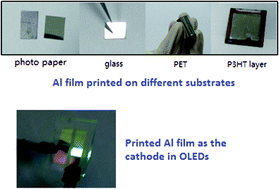A printed aluminum cathode with low sintering temperature for organic light-emitting diodes
Abstract
A printed aluminum cathode with low sintering temperature has been achieved using an aluminum precursor ink, AlH3·O(C3H7)2, which in the presence of a TiCl4 catalyst can be printed to give the required pattern and then sintered at 80 °C for 30 s to form an Al film. The Al cathode of 50 nm thickness has a sheet resistance of 2.09 Ω □−1 and work function of 3.67 eV. The study demonstrates that the low sintering temperature and work function of the printed film, together with its high conductivity and stability, mean that it is well suited for use as an OLED cathode and that it paves the way for fully printed flexible devices.


 Please wait while we load your content...
Please wait while we load your content...